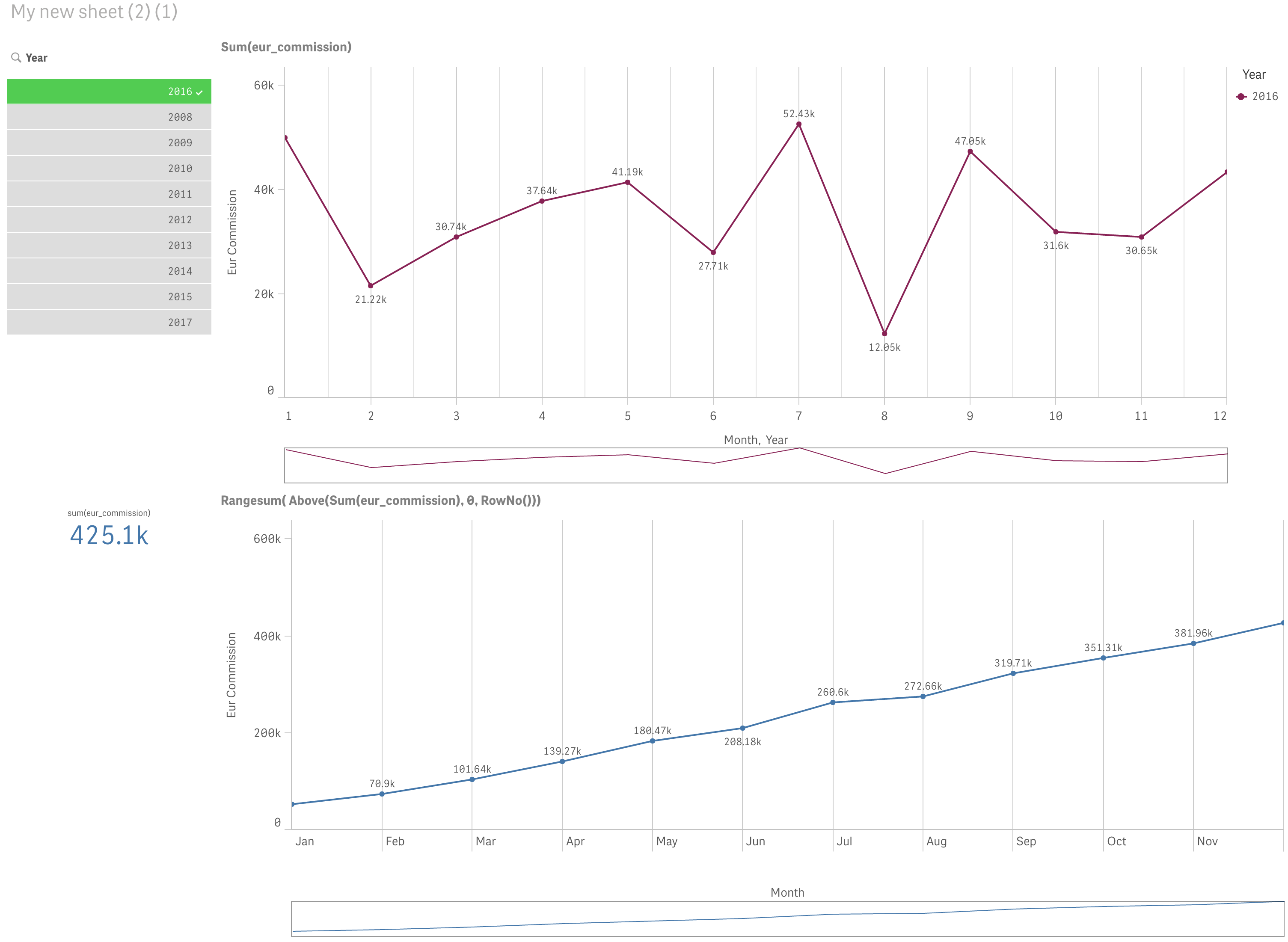Unlock a world of possibilities! Login now and discover the exclusive benefits awaiting you.
- Qlik Community
- :
- Forums
- :
- Analytics
- :
- New to Qlik Analytics
- :
- Re: Line Chart: running total with multiple dimens...
- Subscribe to RSS Feed
- Mark Topic as New
- Mark Topic as Read
- Float this Topic for Current User
- Bookmark
- Subscribe
- Mute
- Printer Friendly Page
- Mark as New
- Bookmark
- Subscribe
- Mute
- Subscribe to RSS Feed
- Permalink
- Report Inappropriate Content
Line Chart: running total with multiple dimensions (month, year)
Dimension1: Month
Dimension2: Year
Measure: Eur_commission (amount)
I can calculate running total with 1 dimension only (month) using the formula:
Rangesum( Above(Sum(eur_commission), 0, RowNo()))

If I add the second dimension (Year), the top chart (no running total) is perfect, the bottom chart (running total)
doesn't work anymore.

- « Previous Replies
- Next Replies »
Accepted Solutions
- Mark as New
- Bookmark
- Subscribe
- Mute
- Subscribe to RSS Feed
- Permalink
- Report Inappropriate Content
This?
Expression (which needs actual fields created in the script)
Aggr(RangeSum(Above(Sum(eur_commission), 0, RowNo())), [reg_date.autoCalendar.Year], [reg_date.autoCalendar.Month])
- Mark as New
- Bookmark
- Subscribe
- Mute
- Subscribe to RSS Feed
- Permalink
- Report Inappropriate Content
Give this a shot:
Aggr(Rangesum( Above(Sum(eur_commission), 0, RowNo())), Year, Month)
or this
Aggr(Rangesum( Above(Sum(eur_commission), 0, RowNo())), Year, (Month, (Numeric, Ascending)))
- Mark as New
- Bookmark
- Subscribe
- Mute
- Subscribe to RSS Feed
- Permalink
- Report Inappropriate Content
Thanks SunnyT,
In facts, I studied your previous replies to other similar questions and I was expecting your reply.
I tried both solutions and I can't make them working.
I attached a test app if you would like to crack it!
Thanks
- Mark as New
- Bookmark
- Subscribe
- Mute
- Subscribe to RSS Feed
- Permalink
- Report Inappropriate Content
This?
Expression (which needs actual fields created in the script)
Aggr(RangeSum(Above(Sum(eur_commission), 0, RowNo())), [reg_date.autoCalendar.Year], [reg_date.autoCalendar.Month])
- Mark as New
- Bookmark
- Subscribe
- Mute
- Subscribe to RSS Feed
- Permalink
- Report Inappropriate Content
This is a very enlightening reply and is fixing many of my issue of newbie.
In facts, I widely use the defined Dimensions (as shortcut and as easy interface with the lingo of the column names) and probably for this reason many scripts I'm using are failing.
Thank you very much.
- Mark as New
- Bookmark
- Subscribe
- Mute
- Subscribe to RSS Feed
- Permalink
- Report Inappropriate Content
I am glad I was able to offer help.
Best,
Sunny
- Mark as New
- Bookmark
- Subscribe
- Mute
- Subscribe to RSS Feed
- Permalink
- Report Inappropriate Content
Hi,
I am also struggling with similar issue in qlikview. Could you please send me qlikview file as I am not able to open .qvf file.
When I tried using same formula as mentioned in other replies, it is giving very weird results.
Aggr(RangeSum(Above(Sum(eur_commission), 0, RowNo())), [reg_date.autoCalendar.Year], [reg_date.autoCalendar.Month])
- Mark as New
- Bookmark
- Subscribe
- Mute
- Subscribe to RSS Feed
- Permalink
- Report Inappropriate Content
Which version of QlikView are you using?
- Mark as New
- Bookmark
- Subscribe
- Mute
- Subscribe to RSS Feed
- Permalink
- Report Inappropriate Content
I am using Qlikview 12
- Mark as New
- Bookmark
- Subscribe
- Mute
- Subscribe to RSS Feed
- Permalink
- Report Inappropriate Content
QV12 is good....Would you be able to share your expression that you used and images of what you have?
- « Previous Replies
- Next Replies »